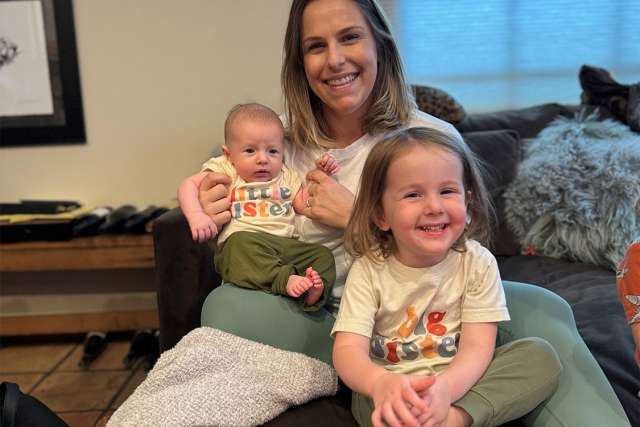After Sabrina Dukhovny gave birth in December 2020, her breastfeeding experience was not an easy one.
Her newborn, Jami, had latching issues, fell asleep at the breast and, as a result, lost more than 10% of her birth weight after leaving the hospital. While weight loss is normal and most babies lose 7%-10% of their birth weight, a baby’s weight should be trending up and be back to birth weight by the second week of life.
Dukhovny went to the doctor every other day to track Jami’s weight and tried an array of feeding methods – from breastfeeding to pumping to using supplementary devices – with the goal of getting her daughter back to her birth weight.
After a difficult first month, Jami returned to a healthy weight, and with the help of Genevieve Thomas, an International Board Certified Lactation Consultant (IBCLC), Dukhovny exclusively pumped her milk for her baby for another 10 months.
But when Dukhovny, now 38, got pregnant again in 2023, she was motivated by her past experience to solely breastfeed her second child.
"Jami's weight loss was very stressful and made the newborn stage less enjoyable than it could have been,” she said. “I also wanted a more traditional breastfeeding experience the second time around."
Because Dukhovny underwent in vitro fertilization (IVF) for her second pregnancy, she received a weekly non-stress test (NST) for the last four weeks of her pregnancy. An NST monitors and records uterine activity and the baby’s heartbeat.
During one of these appointments, Dukhovny spoke to a nurse about her challenging breastfeeding experience, and the nurse suggested she have a lactation appointment before her second child was born. At the lactation appointment, Thomas informed Dukhovny about the team’s Antenatal Milk Expression (AME) Program.
Antenatal milk expression
The AME program at UCLA Health assists high-risk pregnant individuals who are at risk for needing supplementation, such as formula or donor milk. The program helps the pregnant person with expressing and storing colostrum -- the nutrient-dense, highly concentrated first milk, which the body begins producing starting around 16 weeks of pregnancy. After delivery, the patients use their stored colostrum to feed their newborn, in addition to direct breastfeeding.
The program was originally intended for patients with gestational diabetes whose babies faced a greater chance of needing supplementation. Infants of diabetic mothers are at higher risk of low blood sugars after birth, according to Thomas. Likewise, conditions that put newborns at risk for needing formula include low blood sugar secondary to maternal diabetes, or being small or large for their gestational age at birth.
Now, the program also serves pregnant people who are predisposed to delayed milk production, including those with polycystic ovarian syndrome, hypertension, or IVF.
Government and professional health organizations recommend that new birthing parents exclusively breastfeed for the first six months of the baby’s life because of the health benefits for the baby, including providing nutrients and protection against respiratory illness, and the health benefits for the parent, including preventing excessive bleeding, cardiac disease and reducing the risk of breast cancer.
With these breastfeeding benefits in mind, lactation specialists recommend the AME program for high-risk pregnant people whose goal is to solely breastfeed. Thomas also stressed that the lactation team helps parents with an array of feeding goals, and respects a parent's choice to breastfeed, use formula, use both, or pump milk.
An OB-GYN, nurse, or midwife who is treating a patient with one of the risk factors, can refer patients to the AME program, where a lactation specialist will provide supplies to store colostrum and teach hand techniques that will promote colostrum expression.
A patient can also contact the program directly to learn more about the method. Patients are encouraged to share their interest in AME with their OB-GYN, and together they can discuss the safety based on their health history, as stimulating the breast may spark premature labor. AME is only recommended once a parent has reached their 36th week of pregnancy.
Stored colostrum proved handy
Dukhovny was in her 38th week of pregnancy when she met with Thomas and discussed her interest in collecting colostrum before her second child was born.
“I think it’s wonderful when families like Sabrina who had a challenging time breastfeeding are proactive in getting help from lactation specialists with their second child,” Thomas said.
Over a video session, Thomas showed Dukhovny hand techniques to express colostrum as well as different positions to try while breastfeeding. Afterward, Dukhovny started to collect and freeze small amounts of colostrum using 1-4 ml oral feeding syringes for the remaining weeks of her pregnancy – and her efforts paid off.
When Dukhovny went to the hospital to deliver her second daughter, Maddie, in September 2023, she brought her frozen colostrum for freezer storage at UCLA Santa Monica Medical Center. The colostrum came in handy to supplement feedings while she was learning to latch and while waiting for her milk to come in. As a result, the mother of two had more success breastfeeding her second child and was relieved that her stored colostrum contributed to Maddie not having any weight loss issues.
Dukhovny is continuing to breastfeed her daughter and would like parents to know that AME is an option they can explore. "I want people to know that antenatal milk expression is an option and that learning about it could help them accomplish their breastfeeding goals if they choose to pursue that route."



